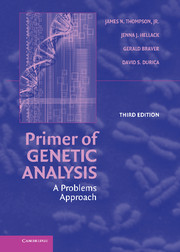Book contents
- Frontmatter
- Contents
- Preface
- Note on Genetic Symbols
- 1 Overview of Genetic Organization and Scale
- 2 Mitosis and Meiosis
- 3 Nucleic Acids: DNA and RNA
- 4 Basic Mendelian Genetics
- 5 Probability and Chi-Square
- 6 Sex-Linkage and Gene Interactions
- 7 Pedigree Analysis
- 8 Overview of Basic Statistical Testing
- 9 Quantitative Inheritance
- 10 Overview of Genetic Mapping
- 11 Assessing Chromosome Linkage Relationships
- 12 Linkage and Mapping in Diploids
- 13 Mapping in Bacteria and Viruses
- 14 Overview of Types of Genetic Change
- 15 Gene Mutation
- 16 Changes in Chromosome Number and Structure
- 17 Protein Synthesis and the Genetic Code
- 18 Gene Regulation and Development
- 19 Overview of Molecular Biology Techniques
- 20 DNA Mapping and Human Genome Analysis
- 21 Basic Population Genetics
- 22 Selection and Evolution
- 23 Practice Tests
- 24 Answers to Practice Tests and Crossword Puzzles
- 25 Landmarks in the History of Genetics
- Glossary
- Reference Tables
6 - Sex-Linkage and Gene Interactions
Published online by Cambridge University Press: 05 June 2012
- Frontmatter
- Contents
- Preface
- Note on Genetic Symbols
- 1 Overview of Genetic Organization and Scale
- 2 Mitosis and Meiosis
- 3 Nucleic Acids: DNA and RNA
- 4 Basic Mendelian Genetics
- 5 Probability and Chi-Square
- 6 Sex-Linkage and Gene Interactions
- 7 Pedigree Analysis
- 8 Overview of Basic Statistical Testing
- 9 Quantitative Inheritance
- 10 Overview of Genetic Mapping
- 11 Assessing Chromosome Linkage Relationships
- 12 Linkage and Mapping in Diploids
- 13 Mapping in Bacteria and Viruses
- 14 Overview of Types of Genetic Change
- 15 Gene Mutation
- 16 Changes in Chromosome Number and Structure
- 17 Protein Synthesis and the Genetic Code
- 18 Gene Regulation and Development
- 19 Overview of Molecular Biology Techniques
- 20 DNA Mapping and Human Genome Analysis
- 21 Basic Population Genetics
- 22 Selection and Evolution
- 23 Practice Tests
- 24 Answers to Practice Tests and Crossword Puzzles
- 25 Landmarks in the History of Genetics
- Glossary
- Reference Tables
Summary
STUDY HINTS
Regular segregation and the assortment of alleles in a heterozygote produce the familiar genotypic and phenotypic ratios that you investigated in Problem Set 4. In a real sense these ratios are also “hypotheses,” in that they are the expectations appropriate to a particular genetic situation. For example, a cross between two heterozygotes, Aa × Aa, yields a 3:1 phenotypic ratio among the offspring. Turning this around, if one finds a 3:1 phenotypic ratio in a family, it is reasonable to hypothesize that the parents were both heterozygotes. Ratios are therefore an important key to establishing the genetic basis of an unfamiliar trait.
Sex-linkage, multiple alleles, gene interactions, and maternal and cytoplasmic effects are natural complications that can modify these underlying patterns and ratios. The secret to solving these types of problems is to be familiar with the clues that are often embedded in modified ratios. A distinct difference between male and female phenotypic ratios leads one to consider the possibility of sex-linkage and/or a maternal or cytoplasmic involvement. Lethality would lead to truncated ratios (e.g., 1:2), whereas the gene interactions such as epistasis would merge certain genotypic classes into the same phenotypic class. Textbooks often describe a large number of these modified ratios, but for convenience we have summarized some of the most commonly encountered ones in Table 6.1.
In addition to traits that can be traced to nuclear genes and their interactions, phenotypes are often dependent upon cytoplasmic interactions.
- Type
- Chapter
- Information
- Primer of Genetic AnalysisA Problems Approach, pp. 55 - 69Publisher: Cambridge University PressPrint publication year: 2007



